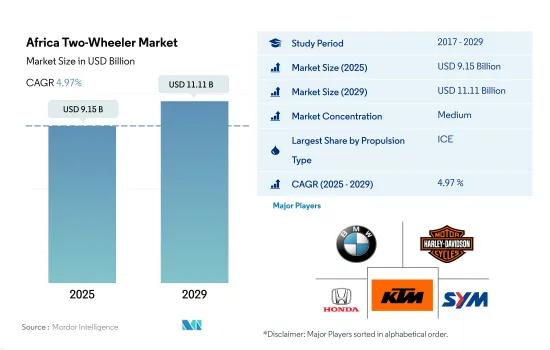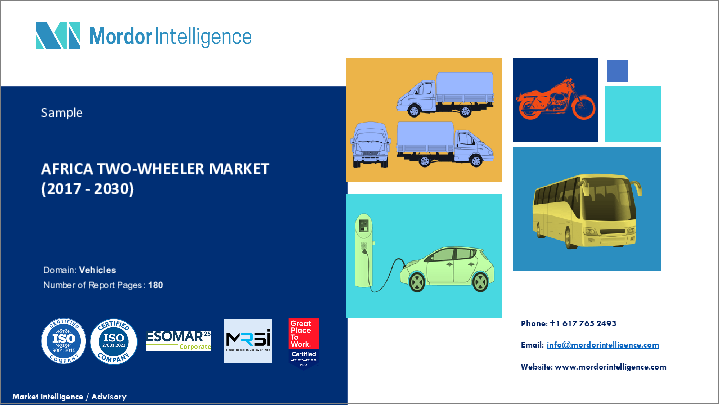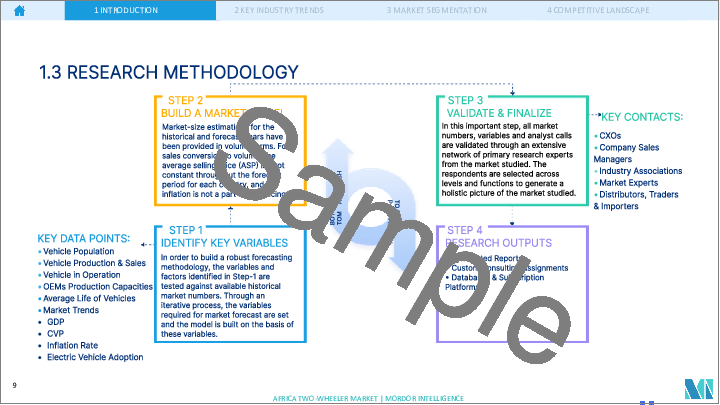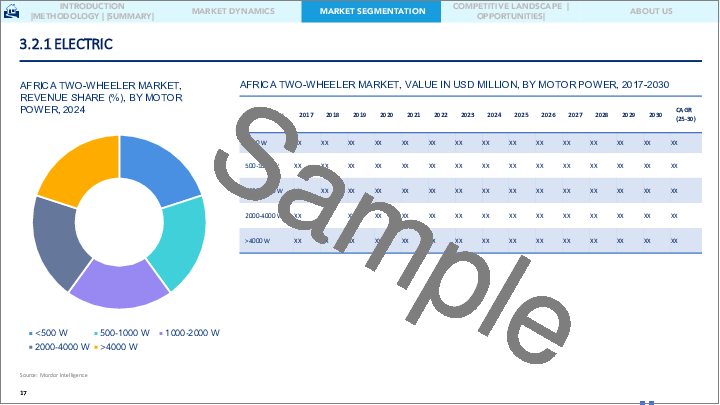|
|
市場調査レポート
商品コード
1692147
アフリカの二輪車:市場シェア分析、産業動向と統計、成長予測(2025~2030年)Africa Two-Wheeler - Market Share Analysis, Industry Trends & Statistics, Growth Forecasts (2025 - 2030) |
||||||
カスタマイズ可能
適宜更新あり
|
|||||||
| アフリカの二輪車:市場シェア分析、産業動向と統計、成長予測(2025~2030年) |
|
出版日: 2025年03月18日
発行: Mordor Intelligence
ページ情報: 英文 180 Pages
納期: 2~3営業日
|
全表示
- 概要
- 目次
概要
アフリカの二輪車の市場規模は2025年に91億5,000万米ドルと推定・予測され、2029年には111億1,000万米ドルに達し、予測期間(2025-2029年)のCAGRは4.97%で成長すると予測されます。

アフリカの二輪車市場は、都市化と持続可能な輸送ソリューションへの需要に牽引され、著しい成長を遂げようとしています。
- 2023年、アフリカの二輪車市場は回復力と成長を示し、販売台数は188万台に達し、2022年の185万台から改善しました。この成長は、手頃な価格、多様な地形に対応できる柔軟性、電動二輪車(E2W)を含む持続可能で効率的なモビリティ・ソリューションに対する消費者の関心の高まりによって、アフリカ大陸全体で二輪車への依存度が高まっていることを浮き彫りにしています。
- 2024年の予測では、販売台数は199万台と顕著な増加を見込んでおり、これは都市部と農村部の両方の交通ニーズに不可欠な乗り物としての二輪車に対する旺盛な需要を反映しています。交通安全の改善、インフラの強化、環境にやさしい交通手段の促進に重点を置いたアフリカ各国の政府の取り組みは、二輪車市場にプラスの影響を与えています。E2Wに対する政策やインセンティブはアフリカ大陸によって異なるが、世界の動向や地域の環境目標に合わせて、持続可能なモビリティへと徐々にシフトしています。
- 2024年から2030年にかけて、アフリカの二輪車市場は大幅な成長を遂げ、予測期間終了時には販売台数が232万5,000台に達する可能性があります。このような成長が見込まれる背景には、都市化の進展、経済開発、利用しやすい交通手段への切実なニーズがあります。技術、手頃な価格、インフラの改善、環境維持に対する意識の高まりによってE2Wの普及が進む可能性があり、アフリカ全域で二輪車市場がダイナミックに拡大する舞台となっています。
アジアの二輪車市場は、都市化、経済的要因、手頃な価格で持続可能な輸送ソリューションに対する需要の高まりによって力強い成長を遂げています。
- アフリカの二輪車市場は、都市化、経済開拓、手頃な価格で効率的な輸送ソリューションに対する需要の高まりを背景に、大きな成長を遂げています。アフリカ大陸の都市が拡大を続けるなか、二輪車は自家用車に代わる実用的で費用対効果の高い選択肢として台頭し、混雑した都市部での移動に高い機動性と利便性を提供しています。
- 南アフリカの二輪車市場は一貫した成長を遂げており、都市モビリティ・ソリューションの分野で極めて重要な役割を担っています。2023年の販売台数は1万5,620台に達し、2022年の1万5,120台から顕著に増加しました。この増加は、手頃な価格、交通渋滞を回避する敏捷性、高騰する燃料費に後押しされ、二輪車が個人的な移動手段の魅力的な代替手段となっていることから、二輪車への関心が国内で急増していることを意味します。
- アフリカのその他の地域の二輪車市場は、経済成長と持続可能な交通手段への嗜好の高まりに後押しされて上昇基調にあります。2023年、この市場セグメントは拡大を示し、販売台数は186万6,540台と、2022年の183万6,980台から緩やかに増加しました。この成長は、二輪車がこの地域のモビリティ・エコシステムにおいて不可欠な役割を果たし、多様な地理的・社会経済的環境において、手頃な価格で利用しやすく、効率的な交通手段を提供していることを裏付けています。
アフリカの二輪車市場動向
アフリカの輸送電化は急速に拡大し、全車種で大幅に増加
- アフリカの輸送セクターの電化は勢いを増しています。2022年の乗用車の電動化率は2%で、2023年には4%に上昇しました。小型商用車(LCV)もこれに続き、電化率は2022年の0.20%から2023年には1.09%に上昇しました。多くのアフリカ諸国で公共交通の重要な部分を占めるバスの電動化率は、2022年の0.50%から2023年には1.96%に急上昇しました。いくつかの地域で人気の高い交通手段である二輪車も、電化率が2022年の1.50%から2023年には4.65%へと飛躍的に上昇しました。
- 過去5年間で、より環境に優しい輸送手段に対するアフリカの取り組みが明らかになりました。乗用車の電動化率は2017年の2%から2022年には5%に上昇しました。アフリカ大陸全域の貨物輸送に欠かせないLCVの電動化率は、2017年の0.20%から2022年には2%近くまで急上昇しました。大量輸送に欠かせないバスは、2017年の0.50%から2022年までに3.42%へと顕著な進歩を遂げました。一方、毎日の通勤に広く使われている二輪車の電化率は、2017年の1.50%から2022年には7.81%に上昇しました。
- 2024年から2030年までの期間を展望すると、アフリカのすべての車両カテゴリーで電動化が一貫して成長すると予想されます。2030年までに、電動コンポーネントを搭載した乗用車は全体の12%を占めると予測されます。LCVの電動化率は6%に達すると予想され、持続可能な都市間移動に欠かせないバスは、10年後までに電動化率が10%に達すると予測されます。効率性と手頃な価格で知られる二輪車セグメントは、2030年までに22%という大幅な電化率を達成する予定です。
アフリカの二輪車産業概要
アフリカの二輪車市場は適度に統合されており、上位5社で49.80%を占めています。この市場の主要企業は以下の通りです。 BMW Motorrad, Harley-Davidson, Honda Motor, KTM Motorcycles and Sym(sorted alphabetically).
その他の特典
- エクセル形式の市場予測(ME)シート
- 3ヶ月のアナリストサポート
目次
第1章 エグゼクティブサマリーと主な調査結果
第2章 レポートのオファー
第3章 イントロダクション
- 調査の前提条件と市場定義
- 調査範囲
- 調査手法
第4章 主要産業動向
- 人口
- 一人当たりGDP
- 自動車購入のための消費者支出(cvp)
- インフレ率
- 自動車ローン金利
- 電化の影響
- EV充電ステーション
- バッテリーパック価格
- Xev新モデル発表
- 燃料価格
- 規制の枠組み
- バリューチェーンと流通チャネル分析
第5章 市場セグメンテーション
- 推進タイプ
- 国名
- 南アフリカ
- アフリカ
第6章 競合情勢
- 主要な戦略動向
- 市場シェア分析
- 企業情勢
- 企業プロファイル
- Bajaj Auto Ltd.
- BMW Motorrad
- Harley-Davidson
- Hero MotoCorp Ltd.
- Honda Motor Co. Ltd.
- KTM Motorcycles
- Lifan Technology(Group)Co. Ltd.
- Suzuki Motor Corporation
- Sym
- TVS Motor Company Limited
- Yamaha Motor Company Limited
第7章 CEOへの主な戦略的質問
第8章 付録
- 世界概要
- 概要
- ファイブフォース分析フレームワーク
- 世界のバリューチェーン分析
- 市場力学(DROs)
- 情報源と参考文献
- 図表一覧
- 主要洞察
- データパック
- 用語集
目次
Product Code: 90861
The Africa Two-Wheeler Market size is estimated at 9.15 billion USD in 2025, and is expected to reach 11.11 billion USD by 2029, growing at a CAGR of 4.97% during the forecast period (2025-2029).

Africa's two-wheeler market is gearing up for significant growth, driven by urbanization and the demand for sustainable transportation solutions
- In 2023, the African two-wheeler market showcased resilience and growth, with sales figures reaching 1,880,000 units, marking an improvement from 2022's 1,850,000 units. This growth highlights the increasing reliance on two-wheelers across the continent, driven by their affordability, flexibility in navigating diverse terrains, and growing consumer interest in sustainable and efficient mobility solutions, including electric two-wheelers (E2Ws).
- The forecast for 2024 anticipates a notable increase in sales to 1,990,000 units, reflecting the robust demand for two-wheelers as essential vehicles for both urban and rural transportation needs. Governmental initiatives across various African countries, focusing on improving road safety, enhancing infrastructure, and promoting environmentally friendly transportation options, have positively impacted the two-wheeler market. While policies and incentives for E2Ws vary across the continent, there is a gradual shift towards sustainable mobility, aligning with global trends and local environmental goals.
- From 2024 to 2030, the African two-wheeler market is poised for significant growth, with projections indicating sales could reach 2,325,000 units by the end of the forecast period. This expected growth is likely to be propelled by ongoing urbanization, economic development, and the critical need for accessible transportation solutions. The potential increase in E2W adoption, driven by improvements in technology, affordability, and infrastructure, alongside a heightened awareness of environmental sustainability, sets the stage for a dynamic expansion of the two-wheeler market across Africa.
The Asian two-wheeler market is experiencing robust growth driven by urbanization, economic factors, and the rising demand for affordable, sustainable transportation solutions
- The African two-wheeler market is experiencing significant growth, driven by urbanization, economic development, and the increasing demand for affordable and efficient transportation solutions. As cities across the continent continue to expand, two-wheelers have emerged as a practical and cost-effective alternative to private cars, offering greater mobility and convenience in navigating congested urban areas.
- South Africa's two-wheeler landscape is witnessing consistent growth, positioning itself as a pivotal player in the realm of urban mobility solutions. The year 2023 witnessed a surge in sales, with figures reaching 15,620 units, a notable uptick from the 15,120 units sold in 2022. This escalation signifies a burgeoning interest in two-wheelers within the nation, fueled by their affordability, agility in navigating traffic congestion, and the escalating cost of fuel, which renders two-wheelers an alluring alternative for personal transportation.
- The Rest of Africa's two-wheeler market finds itself on an upward trajectory, propelled by economic growth and a growing inclination towards sustainable transportation preferences. In 2023, this market segment witnessed an expansion, with sales reaching an impressive 1,866,540 units, a modest increment from the 1,836,980 units sold in 2022. This growth underscores the indispensable role two-wheelers play in the region's mobility ecosystem, offering affordable, accessible, and efficient transportation solutions across diverse geographic and socio-economic landscapes.
Africa Two-Wheeler Market Trends
Africa's transport electrification is expanding rapidly, with significant increases across all vehicle types
- Electrification in Africa's transport sector is gaining momentum. In 2022, the electrification rate for passenger cars was 2%, which climbed to 4% in 2023. Light commercial vehicles (LCVs) followed suit, with their electrification rate rising from 0.20% in 2022 to 1.09% in 2023. Buses, a crucial part of public transport in many African countries, saw their electrification rate surge from 0.50% in 2022 to 1.96% in 2023. Even two-wheelers, a popular mode of transport in several regions, witnessed a significant uptick, with their electrification rate leaping from 1.50% in 2022 to 4.65% in 2023.
- Over the past five years, Africa's commitment to greener transportation has been evident. The electrification rate for passenger cars rose from 2% in 2017 to 5% in 2022. LCVs, crucial for goods transport across the continent, saw their electrification rate surge from 0.20% in 2017 to nearly 2% by 2022. Buses, pivotal for mass transit, made notable progress, going from a 0.50% rate in 2017 to 3.42% by 2022. Meanwhile, the electrification percentage for two-wheelers, widely used for daily commutes, climbed from 1.50% in 2017 to 7.81% in 2022.
- Looking ahead to the period of 2024-2030, all vehicle categories in Africa are expected to witness consistent growth in electrification. By 2030, passenger cars with electric components are projected to account for 12% of the total. LCVs are anticipated to reach a 6% electrification rate, while buses, crucial for sustainable urban and inter-city travel, are forecasted to hit a 10% electrification rate by the end of the decade. The two-wheelers segment, known for its efficiency and affordability, is set to achieve a significant electrification rate of 22% by 2030.
Africa Two-Wheeler Industry Overview
The Africa Two-Wheeler Market is moderately consolidated, with the top five companies occupying 49.80%. The major players in this market are BMW Motorrad, Harley-Davidson, Honda Motor Co. Ltd., KTM Motorcycles and Sym (sorted alphabetically).
Additional Benefits:
- The market estimate (ME) sheet in Excel format
- 3 months of analyst support
TABLE OF CONTENTS
1 EXECUTIVE SUMMARY & KEY FINDINGS
2 REPORT OFFERS
3 INTRODUCTION
- 3.1 Study Assumptions & Market Definition
- 3.2 Scope of the Study
- 3.3 Research Methodology
4 KEY INDUSTRY TRENDS
- 4.1 Population
- 4.2 GDP Per Capita
- 4.3 Consumer Spending For Vehicle Purchase (cvp)
- 4.4 Inflation
- 4.5 Interest Rate For Auto Loans
- 4.6 Impact Of Electrification
- 4.7 EV Charging Station
- 4.8 Battery Pack Price
- 4.9 New Xev Models Announced
- 4.10 Fuel Price
- 4.11 Regulatory Framework
- 4.12 Value Chain & Distribution Channel Analysis
5 MARKET SEGMENTATION (includes market size in Value in USD and Volume, Forecasts up to 2029 and analysis of growth prospects)
- 5.1 Propulsion Type
- 5.2 Country
- 5.2.1 South Africa
- 5.2.2 Rest-of-Africa
6 COMPETITIVE LANDSCAPE
- 6.1 Key Strategic Moves
- 6.2 Market Share Analysis
- 6.3 Company Landscape
- 6.4 Company Profiles
- 6.4.1 Bajaj Auto Ltd.
- 6.4.2 BMW Motorrad
- 6.4.3 Harley-Davidson
- 6.4.4 Hero MotoCorp Ltd.
- 6.4.5 Honda Motor Co. Ltd.
- 6.4.6 KTM Motorcycles
- 6.4.7 Lifan Technology (Group) Co. Ltd.
- 6.4.8 Suzuki Motor Corporation
- 6.4.9 Sym
- 6.4.10 TVS Motor Company Limited
- 6.4.11 Yamaha Motor Company Limited
7 KEY STRATEGIC QUESTIONS FOR VEHICLES CEOS
8 APPENDIX
- 8.1 Global Overview
- 8.1.1 Overview
- 8.1.2 Porter's Five Forces Framework
- 8.1.3 Global Value Chain Analysis
- 8.1.4 Market Dynamics (DROs)
- 8.2 Sources & References
- 8.3 List of Tables & Figures
- 8.4 Primary Insights
- 8.5 Data Pack
- 8.6 Glossary of Terms





